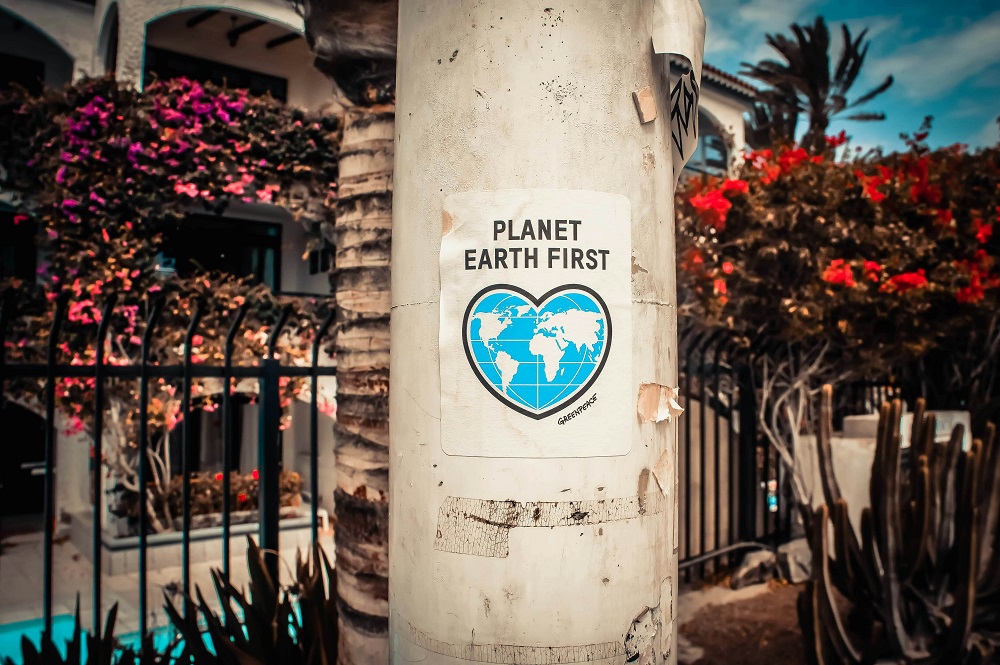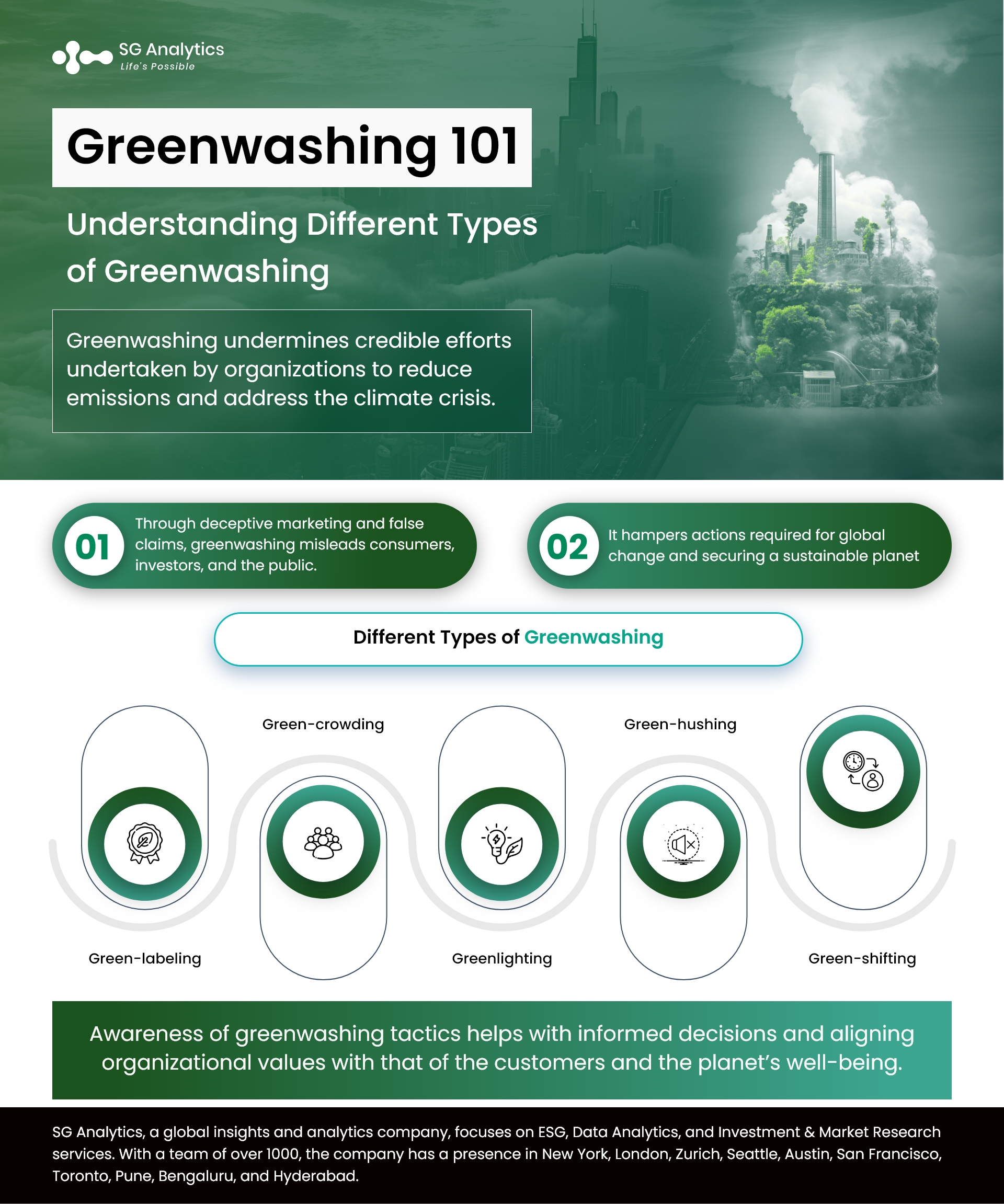With concerns around the climate crisis growing, new legislation is being set by governments across the globe. More and more corporations are talking about sustainability as they are considered one of the biggest contributors to greenhouse gas emissions.
In today’s era, where environmental concerns are at the forefront of consumer consciousness, identifying and understanding the different types of greenwashing practices that can often be used to mislead consumers is critical. Identifying the different types of greenwashing practices and avoiding companies that use those practices is the first step in supporting truly sustainable companies.
Greenwashing – Definition
The concept of greenwashing is not new. Today, consumers are mindful that the environmental claims on the products they purchase can be exaggerated, misleading, or blatantly false.
Greenwashing occurs when an organization makes vague, misleading, or false claims about its products or operations and their environmental impact.
The growing customer demand for sustainable products is leading to increased pressure and legislation from governments. Companies that convey a false impression or offer misleading details about how sustainable their products or practices are use deceptive marketing tactics to capitalize on the growing demands. With false advertising about sustainability on the rise, there is a growing concern over questionable net zero carbon claims. It is, therefore, important for companies to avoid greenwashing and be transparent about their environmental practices and sustainable development.
Read more: ESG in 2024: Climate Adaptation Strategies and Predictions
Brief Overview of Different Types of Greenwashing
Companies engage in greenwashing for various reasons. However, the primary motive is to appeal to an environmentally conscious market segment. This can be for consumers keen on paying for products or solutions considered “green” or for investors looking to support sustainable companies.

The underlying motivation for an environmentally responsible public image is usually financial, as appearing environmentally friendly can lead to better sales and a potentially higher stock price. For this reason, greenwashing and green marketing are prevalent across industries.
Greenwashing undermines credible efforts undertaken by organizations to reduce emissions and address the climate crisis. Through deceptive marketing and false claims, greenwashing misleads consumers, investors, and the public, thus hampering the trust and actions required to bring about global change and secure a sustainable planet.
Five Types of Greenwashing
-
Green-labeling
This type of greenwashing practice is linked to marketing strategies employed by organizations that take advantage of the abundance of environmental labels and initiatives. This greenwashing revolves around misleading consumers by implying that a specific product or initiative is green or sustainable, using misleading and trendy sustainable buzzwords. For investors and stakeholders, it is equally important to examine their organizations’ claims and commitments. This review is essential to avoid potential accusations of green-labeling as misleading claims. If such greenwashing claims are identified, they can negatively impact the company’s reputation.
-
Green-hushing: Staying Silent about Corporate Sustainability Goals
Similarly to green-lighting, green-hushing occurs when an organization’s communications steer away from sustainability claims and underreport sustainability goals and progress to further avoid investor scrutiny. Green-hushing allows organizations to downplay their level of responsibility and accountability for their sustainability actions.
Globally, companies are being scrutinized more closely by stakeholders for their claims of positive environmental and social impacts. Companies’ goals should be realistic and reflect their genuine capacity. Keeping these goals private shrinks accountability and blurs the true picture of the progress made. To avoid accusations of greenwashing, firms are deliberately downplaying or hiding their sustainability goals.
Transparency in ESG commitments, activities, and results provides compliance. It is essential to ensure investments are genuinely sustainable and funds comply with current government regulations.
In the journey towards sustainability, transparency serves as the guiding light, enabling investors to make well-informed decisions and holding companies accountable for their promises. Companies should also set realistic yet ambitious targets.
Read more: ‘Greenwashing’ Is Misleading ESG Investors – Understanding the Gray Areas
-
Green-shifting
This type of greenwashing occurs when companies attempt to shift the fault and responsibility of climate and environmental issues onto their consumers. Such a scenario tends to have a hypocritical undertone that could leave consumers feeling gaslighted. For instance, marketing campaigns run by oil and gas companies encourage consumers to reduce carbon emissions as a personal challenge. While the intent may reflect awareness toward a sustainable future, the reality is that this struggle rests with the industry itself, and the true responsibility lies within these companies.
-
Green-lighting
Companies engaged in green lighting focus their marketing and public relations resources on specific sustainability initiatives to distract attention from damaging activities conducted elsewhere within the organization.
Navigating green-lighting tactics requires a keen assessment of an entire spectrum of organizational activities. While organizations’ sustainability efforts can be commendable, investors and other stakeholders need to also consider the impact of the business activities and impacts across the entire value chain.
Conducting due diligence on the impacts, opportunities, and risks of ESG companies in their sustainable investment portfolios is key to mitigating potential risks. This level of scrutiny acts as a critical tool against potential greenwashing accusations, ensuring sustainability commitments align with the company’s overall practices.

-
Green-crowding
The term describes the act of opting for the bare minimum efforts when it comes to ESG by hiding behind group sustainability. Companies that engage in green crowding may appear to be meeting sustainability standards publicly, but beneath the surface, it could be a strategic plot to divert attention from actual shortcomings. While collaborations on sustainability-focused initiatives are encouraged, the practice results in green-crowding.
While aligning with industry counterparts for a sustainable future is a positive move, it is important to be wary of a potential downside. Instead of imitating the sustainability practices of their industry-leading peers, organizations model their business and marketing practices in line with slow adopters.
Green crowding is a reminder that genuine commitment goes beyond appearances and urges investors to delve deeper into the sustainability practices of the organizations.
How Greenwashing Works?
Greenwashing presents a significant obstacle in tackling the climate change crisis. By misleading the consumer to believe that an organization is doing more to protect the environment than it is, greenwashing advertises false solutions to the climate crisis that distract and delay concrete and credible action.
Greenwashing manifests itself in different ways. These tactics include:
-
Making False Claims
The most straightforward type of greenwashing is where the claims are outright lies. This involves claiming to be on track to reduce a company’s polluting emissions to zero when no credible plan is in place or falsely claiming to be endorsed by an internationally recognized environmental organization.
-
Misdirection and Particular Disclosure
This form of greenwashing presents a product or service as green based on a set of attributes without paying much attention to other important environmental issues. This can include applying intentionally misleading labels, such as “green” or “eco-friendly,” which have no standard definitions and can be easily misinterpreted.
-
Exaggerating the Benefits of Sustainable Practices
This involves exaggerating sustainability practices, claims, or progress in the Corporate Social Responsibility (CSR) report. It also includes being purposely vague or non-specific about an organization’s operations. The information can be based on truth, but what is released to the public is extended beyond what is true or can be verified.
-
Vagueness
This type of greenwashing occurs when a claim is ambiguous or broad. This often implies that a minor improvement has a major impact or promotes a product that meets the minimum regulatory requirements as if it is significantly better than the standard. easily misguiding the consumers.
-
Irrelevant Claims
Irrelevance occurs when a sustainability claim may be truthful but unhelpful for consumers seeking environmentally preferable products.

-
Misleading Visuals
Images can paint a false impression of a product’s environmental benefits. This involves including imagery of nature related to environmental pollution, thus creating a misleading association with being eco-friendly.
-
Lack of Proof
Organizations that commit greenwashing make environmental claims that lack evidence.
-
Shifting Corporate Goals
This type of greenwashing concentrates on corporate sustainability rather than being consumer-facing. It involves changing sustainability targets before achieving them or removing them altogether. Organizations capitalize on the initial benefits of releasing sustainability goals but dodge accountability after potentially failing to achieve them.
Fighting the Fight Against Greenwashing
With the world focusing its collective attention on transitioning to a low-carbon economy, the market for investments to support this transition is also growing exponentially.
Many firms are trying to capitalize on this sustainable market shift by overstating their commitments to and integrating environmental and social factors in their investment products. Owing to this skepticism, investors, asset owners, and financial regulators are scrutinizing the validity of investment products’ sustainability claims and labels. Regulators are also formulating new rules to establish the credibility of the sustainable investment market. And with the requests for ESG-related data only set to grow, avoiding greenwashing is critical for investors and companies alike. This further highlights the significance of good quality data, along with smooth management systems for tracking ESG performance and an informed workforce capable of discerning the truth behind the claims.
Organizations need to take initiatives to establish a solid structure and mitigate tools against greenwashing to ensure transparency, accountability, as well as authenticity in the pursuit of a genuinely green and sustainable future. Organizations can further boost their market share and enhance their public reputation by creating a green image.
Read more: Making Progress in Sustainability: Setting Realistic Paths for Growth

The Role of Informed Awareness to Steer Clear of Greenwashing Claims
Today, the market is flooded with supposedly green products, and distinguishing genuine environmental claims from misleading ones is important. Understanding the types of greenwashing is essential for investors and individuals alike. Not only does this ensure that individuals can make environmentally responsible choices while also holding organizations accountable for their impact, thus enabling them to drive genuine sustainability efforts and sustainable practices.
Moreover, for investors, evaluating enterprises on their actual environmental credentials rather than their marketed image is vital to prevent financial risks associated with investing in firms that might face backlash.
Awareness of greenwashing tactics further ensures that the push for environmental sustainability is genuine and effective. It helps with informed decisions that properly align with the values of the customers and the planet’s well-being.
A leader in ESG Services, SG Analytics offers bespoke sustainability consulting services and research support for informed decision-making. Contact us today if you are in search of an efficient ESG (Environmental, Social, and Governance) integration and management solution provider to boost your sustainable performance.
About SG Analytics
SG Analytics (SGA) is an industry-leading global data solutions firm providing data-centric research and contextual analytics services to its clients, including Fortune 500 companies, across BFSI, Technology, Media & Entertainment, and Healthcare sectors. Established in 2007, SG Analytics is a Great Place to Work® (GPTW) certified company with a team of over 1200 employees and a presence across the U.S.A., the UK, Switzerland, Poland, and India.
Apart from being recognized by reputed firms such as Gartner, Everest Group, and ISG, SGA has been featured in the elite Deloitte Technology Fast 50 India 2023 and APAC 2024 High Growth Companies by the Financial Times & Statista.

